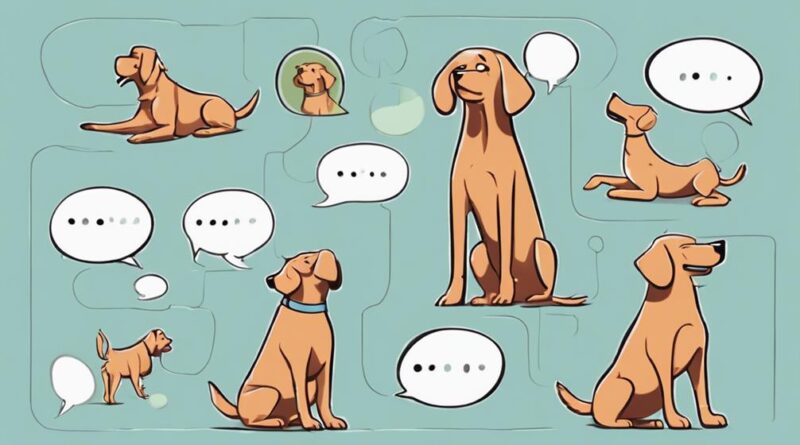Five Tips to Decode Canine Behavior Psychology
Unlock the secrets behind your furry friend's behavior with five key insights into decoding canine psychology.
From subtle tail wags to complex social hierarchies, understanding these cues can deepen your bond with your dog and improve your communication.
Learn how to interpret their actions and reactions to navigate their world with confidence and insight.
Start unraveling the mysteries of your dog's mind today to enhance your relationship and ensure a harmonious coexistence.
Understanding Canine Body Language
Have you ever wondered how to interpret your dog's body language accurately? Understanding canine body language is crucial for building a strong bond with your furry companion.
One key aspect to pay attention to is canine stress signals. Dogs can exhibit stress through behaviors like yawning, lip licking, or avoiding eye contact. It's important to recognize these signs to ensure your dog feels safe and comfortable in different situations.
Another essential part of decoding canine body language is interpreting submissive postures. When a dog displays submissive behavior, they may cower, lower their body, or tuck their tail between their legs. Understanding these postures can help you respond appropriately to your dog's feelings and prevent any potential conflicts.
Deciphering Tail Wagging Signals
To understand your dog's emotions better, pay close attention to the nuances of their tail wagging signals. The way your furry friend wags its tail can reveal a lot about how they're feeling at that moment. Here are four key points to help you decipher your dog's tail wagging signals:
- Wagging Speed: The speed at which your dog wags its tail can indicate its level of excitement or agitation. A fast wag usually signifies a high level of excitement, while a slow wag might indicate caution or hesitation.
- Tail Position: The position of your dog's tail while wagging is crucial. A tail held high while wagging often signals confidence and alertness. Conversely, a tail tucked between the legs while wagging could indicate fear or submission.
- Tail Language: Just like humans use body language to communicate, dogs use their tails to express emotions. Understanding your dog's unique tail language can help strengthen your bond and improve communication.
- Dog Emotions: By observing your dog's tail wagging signals along with other body cues, you can gain insight into their emotions and respond accordingly to support their well-being. Paying attention to these subtle signs can enhance your relationship with your canine companion.
Unraveling Barking Communication Patterns
Understanding your dog's barking communication patterns can provide valuable insights into their needs and emotions. Paying attention to the context and frequency of your dog's barks can help you decipher their messages. Different barking cues convey various meanings, such as excitement, fear, boredom, or alerting to potential threats. For instance, rapid and high-pitched barks are often associated with excitement, while prolonged and low barks may indicate a sense of alertness or warning.
Communication breakdowns may occur when misinterpreting your dog's barking signals. It's essential to observe your dog's body language and the environment to better understand the reasons behind their barks. Sometimes, dogs may bark excessively due to separation anxiety, seeking attention, or responding to other dogs in the vicinity. By being attuned to your dog's barking patterns and the situations triggering them, you can address any underlying issues and strengthen your bond through improved communication.
Exploring Canine Social Hierarchy
Delving into the intricate dynamics of canine social hierarchy reveals fascinating insights into pack behavior and leadership roles among dogs. Understanding dominance dynamics and social structure within a canine pack can shed light on how dogs interact and establish their positions within the group.
Here are four key points to consider when exploring canine social hierarchy:
- Dominance Dynamics: Dogs often display dominance behaviors to establish a hierarchy within the pack. This can include posturing, resource guarding, and controlling access to certain resources.
- Social Structure: Canine social structures are typically organized around a dominant leader or alpha dog, followed by a hierarchy of subordinates. This structure helps maintain order and minimize conflict within the pack.
- Communication Signals: Dogs use various body language and vocalizations to communicate their social status and maintain peace within the group.
- Role of Leadership: The alpha dog is responsible for making decisions, mediating conflicts, and ensuring the pack's well-being. Understanding this leadership role can provide insights into pack dynamics and behavior.
Investigating Pack Mentality in Dogs
Exploring how dogs exhibit pack mentality provides valuable insights into their social behavior and interactions. Pack dynamics play a significant role in understanding how dogs establish hierarchies within their groups. In a pack, dogs rely on social structures to maintain order and cooperation. Within these dynamics, the concept of alpha leadership emerges, where certain dogs assert dominance to maintain control and ensure the pack's well-being.
Alpha leadership is often exhibited through assertive body language, like standing tall, direct eye contact, and confident postures. Dogs that assume alpha roles typically make decisions for the pack, such as leading hunts or determining resting spots. Understanding alpha leadership helps decipher how dogs communicate and resolve conflicts within their social groups.
Observing pack dynamics in dogs can shed light on their behaviors and interactions with other canines and humans. By recognizing the importance of alpha leadership and pack structures, you can gain a deeper understanding of your dog's social needs and tendencies.
Interpreting Aggressive Behavior Triggers
Aggressive behavior triggers in dogs can vary depending on their environment and past experiences. Understanding these triggers is crucial in deciphering your furry friend's behavior. Here are some key points to consider:
- Aggression Triggers: Dogs can exhibit aggressive behavior when they feel threatened or scared. Identifying what triggers this response in your dog is essential to address the issue effectively.
- Past Traumatic Experiences: Dogs that have had negative encounters in the past may display aggression as a defense mechanism. Recognizing these past experiences can help you provide the necessary support and training.
- Territorial Behavior: Dogs can become aggressive when they feel their territory is being invaded. It's important to understand your dog's territorial triggers to prevent potential conflicts.
- Fear Responses: Fear is a common trigger for aggressive behavior in dogs. Recognizing signs of fear in your dog can help you intervene early and prevent escalation.
Analyzing Fear and Anxiety Responses

Understanding how fear and anxiety manifest in your canine companion is crucial for fostering a supportive and secure environment. Dogs can exhibit fear triggers in various ways, such as trembling, excessive barking, hiding, or avoidance behaviors. It's essential to pay attention to these signs to identify the root cause of their distress.
When it comes to anxiety management, creating a safe space for your dog can help alleviate their fears. Providing a comfortable den-like area where they can retreat to can offer a sense of security. Additionally, using positive reinforcement techniques and maintaining a consistent routine can help reduce their anxiety levels.
To effectively manage your dog's anxiety, it's important to address any underlying issues that may be contributing to their fearful behavior. This could involve desensitization training, seeking professional help, or making environmental adjustments to create a more calming atmosphere. By understanding your canine companion's fear triggers and implementing proper anxiety management techniques, you can help them feel more secure and at ease in their surroundings.
Decoding Canine Play Behavior
To better comprehend your canine companion's behaviors, let's now unravel the intricacies of decoding their play behavior. Understanding how dogs engage in playful interactions can provide valuable insights into their emotions and social dynamics. Here are some key points to consider:
- Body Language: Pay attention to your dog's body language during play. Loose, relaxed movements often indicate a happy and engaged state, while stiff or tense postures might suggest discomfort.
- Tail Wagging: Contrary to popular belief, a wagging tail doesn't always mean a dog is friendly. The speed, height, and direction of the wag can convey different messages, so observe this behavior in context.
- Play Bows: Dogs often initiate play with a characteristic 'play bow,' where they lower their front legs while keeping their rear end up. This posture is a clear invitation to interact and signals a playful intent.
- Vocalizations: Canine communication extends beyond barks. Growls during play can be playful, known as a play-growl, but understanding the context and accompanying body language is crucial in decoding their true meaning.
Frequently Asked Questions
Can Dogs Communicate With Each Other Across Different Breeds?
Dogs can communicate effectively with each other across different breeds. They use a variety of communication signals, such as body language, vocalizations, and scent marking, to interact and convey information.
Breed interactions are influenced by these shared forms of communication, allowing dogs to understand each other's intentions and needs regardless of their breed differences. This innate ability to communicate helps dogs form social bonds and navigate their interactions with one another smoothly.
How Do Dogs Show Affection Towards Humans?
Dogs show affection towards humans in many ways. They use body language like wagging their tail to express happiness. Additionally, they may show love by licking you or cuddling up close. These actions are their way of communicating their affection for you.
Keep an eye out for these signs to understand how much your furry friend cares about you!
Do Dogs Experience Jealousy Towards Other Pets?
Dogs can indeed experience jealousy towards other pets due to social dynamics and potential rivalry. This can be evident in their body language and reactions when they feel their territory or attention is being encroached upon.
Keep an eye out for signs like growling, snapping, or even attempts to push the other pet away. Understanding these behaviors can help you manage their interactions and ensure a harmonious environment at home.
Can Dogs Hold Grudges Against Their Owners?
Dogs possess emotional intelligence and can exhibit canine forgiveness, but they aren't prone to holding grudges against their owners. Trust-building and positive reinforcement through behavioral conditioning play key roles in fostering a strong bond.
What Role Does Scent Play in Canine Communication and Behavior?
Scent communication is crucial in canine psychology. Dogs rely on their sense of smell to gather information about their surroundings, other animals, and even people. Through scent, they can communicate with each other, marking territories, identifying individuals, and expressing emotions.
Understanding the role of scent in canine behavior can provide valuable insights into how dogs interact and navigate their world.
Conclusion
Now that you've learned these five tips to decode canine behavior psychology, you'll be better equipped to understand and communicate with your furry friend.
By paying attention to their body language, tail wagging signals, barking patterns, social hierarchy, and pack mentality, you can build a stronger bond with your dog.
Remember to also consider aggressive behavior triggers, fear and anxiety responses, and play behavior to ensure a healthy and happy relationship with your canine companion.
